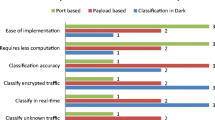Abstract
As the Internet continues to grow both in size and in terms of the volume of traffic it carries, more and more networks in the different parts of the world are relying on an increasing number of distinct ways to exchange traffic with one another. As a result, simple questions such as “What is the application mix in today’s Internet?” may produce non-informative simple answers unless they are refined by specifying the vantage point where the traffic is observed, the networks that are involved, or even the type of interconnection used.
In this paper, we revisit the question of the application mix in today’s Internet and make two main contributions. First, we develop a methodology for classifying the application mix in packet-sampled traces collected at one of the largest IXPs in Europe and worldwide. We show that our method can classify close to 95 % of the traffic by relying on a stateful classification approach that uses payload signatures, communication patterns, and port-based classification only as a fallback. Second, our results show that when viewed from this vantage point and aggregated over all the IXP’s public peering links, the Internet’s application mix is very similar to that reported in other recent studies that relied on different vantage points, peering links or classification methods. However, the observed aggregate application mix is by no means representative of the application mix seen on individual peering links. In fact, we show that the business type of the ASes that are responsible for much of the IXP’s total traffic has a strong influence on the application mix of their overall traffic and of the traffic seen on their major peering links.
Access this chapter
Tax calculation will be finalised at checkout
Purchases are for personal use only
Similar content being viewed by others
Notes
- 1.
Traffic traversing the IXP’s private peering links is not collected and not considered here.
- 2.
Note that the applications belonging to the “other known” traffic class vary across studies.
References
BitTorrent Protocol Specification v 1.0. https://wiki.theory.org/BitTorrentSpecification
Digital Trends article, 12 October 2013. http://www.digitaltrends.com/opinion/bittorrents-image-problem/
L7-filter. http://l7-filter.sourceforge.net/
Sandvine Global Internet Phenomena, 1H 2014. https://www.sandvine.com/downloads/general/global-internet-phenomena/
Sandvine Traffic Classification. https://www.sandvine.com/technology/traffic-classification.html
uTorrent Transport Protocol Specification. http://www.bittorrent.org/beps/bep_0029.html
Ager, B., Chatzis, N., Feldmann, A., Sarrar, N., Uhlig, S., Willinger, W.: Anatomy of a large European IXP. In: ACM SIGCOMM (2012)
Alcock, S., Nelson, R.: Libprotoident: Traffic classification using lightweight packet inspection. University of Waikato, Technical report (2012)
Bonfiglio, D., Mellia, M., Meo, M., Ritacca, N., Rossi, D.: Tracking down skype traffic. In: IEEE INFOCOM (2008)
Callado, A., Kamienski, C., Szabo, G., Gero, B., Kelner, J., Fernandes, S., Sadok, D.: A survey on internet traffic identification. IEEE Commun. Surv. Tutor. 11(3), 37–52 (2009)
Carela-Español, V., Bujlow, T., Barlet-Ros, P.: Is our ground-truth for traffic classification reliable? In: Faloutsos, M., Kuzmanovic, A. (eds.) PAM 2014. LNCS, vol. 8362, pp. 98–108. Springer, Heidelberg (2014)
Czyz, J., Allman, M., Zhang, J., Iekel-Johnson, S., Osterweil, E., Bailey, M.: Measuring IPv6 adoption. In: ACM SIGCOMM (2014)
Dainotti, A., Pescape, A., Claffy, K.: Issues and future directions in traffic classification. IEEE Netw. Mag. 26(1), 35–40 (2012)
Finamore, A., Mellia, M., Meo, M., Munafo, M., Rossi, D.: Experiences of Internet traffic monitoring with Tstat. IEEE Netw. 25(3), 8–14 (2011)
Finamore, A., Mellia, M., Meo, M., Rossi, D.: KISS: Stochastic packet inspection classifier for UDP traffic. IEEE/ACM Trans. Netw. 18(5), 1505–1515 (2010)
Gerber, A., Doverspike, R.: Traffic types and growth in backbone networks. In: OFC/NFOEC (2011)
Iliofotou, M., Gallagher, B., Eliassi-Rad, T., Xie, G., Faloutsos, M.: Profiling-by-association: A resilient traffic profiling solution for the internet backbone. In: ACM CoNEXT (2010)
Karagiannis, T., Broido, A., Faloutsos, M., claffy, Kc.: Transport layer identification of P2P traffic. In: ACM IMC (2004)
Karagiannis, T., Papagiannaki, K., Faloutsos, M.: BLINC: multilevel traffic classification in the dark. In: ACM SIGCOMM (2005)
Kim, H., Claffy, K., Fomenkov, M., Barman, D., Faloutsos, M., Lee, K.-Y.: Internet traffic classification demystified: Myths, caveats, and the best practices. In: ACM CoNEXT (2008)
Labovitz, C., Lekel-Johnson, S., McPherson, D., Oberheide, J., Jahanian, F.: Internet inter-domain traffic. In: ACM SIGCOMM (2010)
Lee, C., Lee, D.K., Moon, S.: Unmasking the growing UDP traffic in a campus network. In: Taft, N., Ricciato, F. (eds.) PAM 2012. LNCS, vol. 7192, pp. 1–10. Springer, Heidelberg (2012)
Maier, G., Feldmann, A., Paxson, V., Allman, M.: On dominant characteristics of residential broadband internet traffic. In: ACM IMC (2009)
Moore, A.W., Papagiannaki, K.: Toward the accurate identification of network applications. In: Dovrolis, C. (ed.) PAM 2005. LNCS, vol. 3431, pp. 41–54. Springer, Heidelberg (2005)
Nguyen, T.T.T., Armitage, G.: A survey of techniques for internet traffic classification using machine learning. IEEE Commun. Surv. Tutor. 10(4), 56–76 (2008)
Popa, L., Ghodsi, A., Stoica, I.: HTTP as the narrow waist of the future Internet. In: ACM HotNets (2010)
Richter, P., Smaragdakis, G., Feldmann, A., Chatzis, N., Boettger, J., Willinger, W.: Peering at peerings: On the role of IXP route servers. In: ACM IMC (2014)
InMon–sFlow. http://sflow.org/
Valenti, D., Rossi, D., Dainotti, A., Pescapè, A., Finamore, A., Mellia, M.: Reviewing traffic classification. In: TMA (2013)
Wang, L., Kangasharju, J.: Real-world sybil attacks in BitTorrent mainline DHT. In: IEEE GLOBECOM (2012)
Acknowledgements
We want to express our gratitude towards the IXP operators for their generous support and feedback. We thank the anonymous reviewers for their helpful feedback. Georgios Smaragdakis was supported by the EU Marie Curie IOF “CDN-H” (PEOPLE-628441).
Author information
Authors and Affiliations
Corresponding author
Editor information
Editors and Affiliations
Rights and permissions
Copyright information
© 2015 Springer International Publishing Switzerland
About this paper
Cite this paper
Richter, P., Chatzis, N., Smaragdakis, G., Feldmann, A., Willinger, W. (2015). Distilling the Internet’s Application Mix from Packet-Sampled Traffic. In: Mirkovic, J., Liu, Y. (eds) Passive and Active Measurement. PAM 2015. Lecture Notes in Computer Science(), vol 8995. Springer, Cham. https://doi.org/10.1007/978-3-319-15509-8_14
Download citation
DOI: https://doi.org/10.1007/978-3-319-15509-8_14
Published:
Publisher Name: Springer, Cham
Print ISBN: 978-3-319-15508-1
Online ISBN: 978-3-319-15509-8
eBook Packages: Computer ScienceComputer Science (R0)




